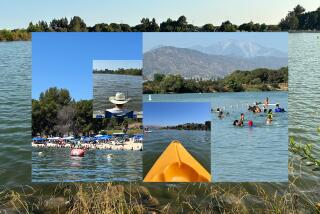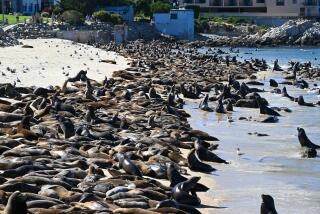Coyotes Are Being Fenced Out at Mono Lake : Environment: With the water level low, an electronic barrier will protect gull chicks in their island nests.
- Share via
In their pursuit of tasty but endangered gull chicks, those wily Mono Lake coyotes will face a new obstacle this spring that would make the Road Runner proud--an electric fence.
The U.S. Forest Service today will string 1,100 yards of low-voltage wire across a slice of the brine lake’s north shore. The hope is that a jolt on the nose will deter the pesky critters from crossing shallow water to devour nestlings on Negit Island.
The contest--man versus coyote versus gull chicks--is an annual ritual at the scenic Eastern Sierra lake, the center of a lengthy legal dispute over the Los Angeles water supply. But electricity is an escalation in firepower.
Guardians of the environmentally sensitive lake say the water level has dropped so low that a land bridge virtually connects Negit Island, home of an important West Coast gull rookery, to the shore.
Coyotes and an occasional bobcat still must cross a short stretch of water a foot or two deep. But “coyotes will walk through the shallow water and even swim to get across,” said Nancy Upham, manager of the Mono Basin Scenic Area, established by Congress in 1984.
When Mono Lake has enough water, the island sits about 50 yards offshore, safe from predators. Coyotes won’t try to swim that distance, Upham says.
In 1979, the lake level dropped so low that the land bridge to Negit Island was fully exposed. A fence was built on the island to discourage the coyotes, but as the water evaporated they simply walked around the ends of the fence and decimated the nests.
A winter of heavy snow added several feet of water to the lake, isolating the island rookery again and easing the threat.
Mono Lake has been the focus of legal battles ever since, pitting the city of Los Angeles against the National Audubon Society, trout anglers and the Mono Lake Committee, an activist group based in Los Angeles and in Lee Vining, the only town on the lake shore.
Los Angeles for about four decades has supplemented its water supply by diverting streams that feed Mono Lake. One result has been the gradual shrinking of the lake, giving predators easy access to the gull nests and exposing miles of former lake bottom to winds that kick up alkali dust into notorious dust storms.
In the last year, several courts have faulted Los Angeles for environmental damage in the Mono Lake Basin. The city was ordered to release enough water to protect the gulls, who nest at Mono Lake from late March until August.
But light snowfall this winter has slowed the lake’s rise, and the surface is not expected to reach a minimum safe level before next year, Upham said.
The $2,000 electric fence, which will be powered by batteries and solar generators, is scheduled to be erected today by volunteers. It will be taken down when the gulls leave at the end of the nesting season, Upham said.
“This is merely a temporary, emergency measure,” she said.
Mono Lake’s coyotes have proved persistent and creative in the past, and no one is willing to guarantee that the fence will work. But electricity has discouraged coyotes elsewhere in the West.
“It is based on the theory that coyotes lead with their nose,” said Martha Davis, executive director of the Mono Lake Committee.
More to Read
Sign up for Essential California
The most important California stories and recommendations in your inbox every morning.
You may occasionally receive promotional content from the Los Angeles Times.










